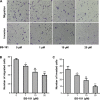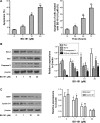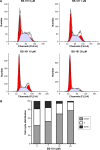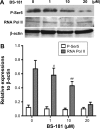Selective CDK7 inhibition with BS-181 suppresses cell proliferation and induces cell cycle arrest and apoptosis in gastric cancer
- PMID: 27042010
- PMCID: PMC4801149
- DOI: 10.2147/DDDT.S86317
Selective CDK7 inhibition with BS-181 suppresses cell proliferation and induces cell cycle arrest and apoptosis in gastric cancer
Abstract
Cyclin-dependent kinase (CDK) family members have been considered as attractive therapeutic targets for cancer. In this study, we aim to investigate the anticancer effects of a selective CDK7 inhibitor, BS-181, in gastric cancer (GC) cell line. Human GC cells (BGC823) were cultured with or without BS-181 at different concentrations for 24-72 hours. BS-181 significantly reduced the activity of CDK7 with downregulation of cyclin D1 and XIAP in GC cells. Treatment with BS-181 induced cell cycle arrest and apoptosis. The expression of Bax and caspase-3 was significantly increased, while Bcl-2 expression was decreased in cells treated with BS-181. In addition, the inhibition of CDK7 with BS-181 resulted in reduced rates of proliferation, migration, and invasion of gastric cells. Those results demonstrated the anticancer activities of selective CDK7 inhibitor BS-181 in BGC823 cells, suggesting that CDK7 may serve as a novel therapeutic target or the treatment of GC.
Keywords: BS-181; anticancer activities; gastric cancer; selective CDK7 inhibitor.
Figures





Similar articles
-
The development of a selective cyclin-dependent kinase inhibitor that shows antitumor activity.Cancer Res. 2009 Aug 1;69(15):6208-15. doi: 10.1158/0008-5472.CAN-09-0301. Epub 2009 Jul 28. Cancer Res. 2009. PMID: 19638587 Free PMC article.
-
Danusertib, a potent pan-Aurora kinase and ABL kinase inhibitor, induces cell cycle arrest and programmed cell death and inhibits epithelial to mesenchymal transition involving the PI3K/Akt/mTOR-mediated signaling pathway in human gastric cancer AGS and NCI-N78 cells.Drug Des Devel Ther. 2015 Mar 2;9:1293-318. doi: 10.2147/DDDT.S74964. eCollection 2015. Drug Des Devel Ther. 2015. PMID: 25767376 Free PMC article.
-
Xylocydine, a novel Cdk inhibitor, is an effective inducer of apoptosis in hepatocellular carcinoma cells in vitro and in vivo.Cancer Lett. 2010 Jan 28;287(2):196-206. doi: 10.1016/j.canlet.2009.06.011. Epub 2009 Jul 17. Cancer Lett. 2010. PMID: 19616371
-
CDK7 Inhibitors in Cancer Therapy: The Sweet Smell of Success?J Med Chem. 2020 Jul 23;63(14):7458-7474. doi: 10.1021/acs.jmedchem.9b01985. Epub 2020 Mar 19. J Med Chem. 2020. PMID: 32150405 Review.
-
Cyclin-dependent kinase 7 inhibitors in cancer therapy.Future Med Chem. 2020 May;12(9):813-833. doi: 10.4155/fmc-2019-0334. Epub 2020 Mar 25. Future Med Chem. 2020. PMID: 32208930 Review.
Cited by
-
G1 Cell Cycle Arrest and Extrinsic Apoptotic Mechanisms Underlying the Anti-Leukemic Activity of CDK7 Inhibitor BS-181.Cancers (Basel). 2020 Dec 19;12(12):3845. doi: 10.3390/cancers12123845. Cancers (Basel). 2020. PMID: 33352782 Free PMC article.
-
Expression of CDK7 correlates with molecular subtypes and predicts clinical outcomes in breast cancer.Transl Cancer Res. 2021 Feb;10(2):669-680. doi: 10.21037/tcr-20-2911. Transl Cancer Res. 2021. PMID: 35116400 Free PMC article.
-
The Regulation of Cyclins and Cyclin-Dependent Kinases in the Development of Gastric Cancer.Int J Mol Sci. 2023 Feb 2;24(3):2848. doi: 10.3390/ijms24032848. Int J Mol Sci. 2023. PMID: 36769170 Free PMC article. Review.
-
TFIIH: New Discoveries Regarding its Mechanisms and Impact on Cancer Treatment.J Cancer. 2016 Nov 9;7(15):2258-2265. doi: 10.7150/jca.16966. eCollection 2016. J Cancer. 2016. PMID: 27994662 Free PMC article. Review.
-
CDKs in Sarcoma: Mediators of Disease and Emerging Therapeutic Targets.Int J Mol Sci. 2020 Apr 24;21(8):3018. doi: 10.3390/ijms21083018. Int J Mol Sci. 2020. PMID: 32344731 Free PMC article. Review.
References
-
- Bertuccio P, Chatenoud L, Levi F, et al. Recent patterns in gastric cancer: a global overview. Int J Cancer. 2009;125(3):666–673. - PubMed
-
- Jemal A, Center MM, DeSantis C, Ward EM. Global patterns of cancer incidence and mortality rates and trends. Cancer Epidemiol Biomarkers Prev. 2010;19(8):1893–1907. - PubMed
-
- Bregman DB, Pestell RG, Kidd VJ. Cell cycle regulation and RNA polymerase II. Front Biosci. 2000;5:D244–D257. - PubMed
-
- Harper JW, Elledge SJ. The role of Cdk7 in CAK function, a retro-retrospective. Genes Dev. 1998;12(3):285–289. - PubMed
-
- Fisher RP. Secrets of a double agent: CDK7 in cell-cycle control and transcription. J Cell Sci. 2005;118(pt 22):5171–5180. - PubMed
MeSH terms
Substances
LinkOut - more resources
Full Text Sources
Other Literature Sources
Medical
Research Materials
Miscellaneous

